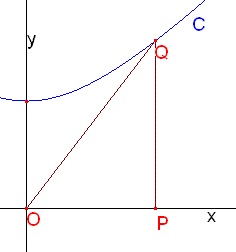���낢��ȗ��̖̂�� ��7�߁@�o�Ȑ�(����5) ����ł́C�������������Ă݂悤�D ���P ���̎� $x=\tan \theta$,$y=\dfrac{1}{\cos \theta} \ \ (0 \leqq \theta$��$\dfrac{\pi}{2})$ �ŕ\�����$xy$���ʏ�̋Ȑ�$C$���l����D �萔$t>0$�ɑ��ē_$P(t,0)$��ʂ�C$x$���ɐ����Ȓ���$l$�ƋȐ�$C$�̌�_��$Q$�Ƃ���D�Ȑ�$C$�C$x$���C$y$������ђ���$l$ �ň͂܂ꂽ�}�`�̖ʐς�$S_1$�Ƃ���D ���̂Ƃ�$S_1$��$t$�ŕ\���D �i�����Q�R�N�@�����H��E����j(�ꕔ��) ���̖��͎��̂悤�ɏ����������Ƃ��ł���D  ���P'
���P'���̎� $y=\sqrt{x^2+1}$ �ŕ\�����$xy$���ʏ�̋Ȑ�$C$���l����D �萔$t>0$�ɑ��ē_$P(t,0)$��ʂ�C$x$���ɐ����Ȓ���$l$�ƋȐ�$C$�̌�_��$Q$�Ƃ���D�Ȑ�C�Cx���Cy������ђ���$l$ �ň͂܂ꂽ�}�`�̖ʐς�$S_1$�Ƃ���D $S_1$��$t$�ŕ\���D �Ȃ��C���̔N�ɂ͒Óc�m��ł�������肪�o�肳��Ă��܂��D $S_1$�̒l��$\sqrt{x^2+1}$�̐ϕ���p����ΊȒP�Ȃ̂ŁC���Z�̈Ӗ������˂Đ�ɒl�͋��߂Ă����܂��傤�D $\displaystyle S_1=\int_0^t \sqrt{x^2+1}dx=\dfrac{\log (\sqrt{t^2+1}+t)+t\sqrt{1+t^2}}{2}$ �ƂȂ�܂��D �P �o��� $x=\tan \theta$,$y=\dfrac{1}{\cos \theta}$ �ɂ��u���ϕ����Ӑ}���Ă��܂��D���̕��@�ʼn����܂��傤�D $\theta _0$�� $t=\tan \theta _0 \ \ �i0\leqq \theta _0$��$\frac{\pi}{2})$ �Œ�`���܂��D $\displaystyle S_1=\int_0^t ydx=\int_0^{\theta _0}\dfrac{d\theta}{\cos ^3 \theta}$�E�E�E�@ �ł���D ���̂܂܌v�Z���Ă��悢���C�����ϕ���p����Ə����v�Z���y�ɂȂ�D �@�� $\displaystyle \int_0^{\theta _0}\dfrac{1}{\cos \theta}(\tan \theta)'d\theta$ $\displaystyle =[\dfrac{1}{\cos \theta}\cdot \tan \theta]_0^{\theta _0} -\int_0^{\theta _0}\dfrac{\sin ^2 \theta}{\cos ^3 \theta}d\theta$ ��Q���� $\displaystyle \int_0^{\theta _0}\dfrac{1}{\cos ^3 \theta }d\theta -\int_0^{\theta _0}\dfrac{1}{\cos \theta}d\theta$ �ł��邩�� $\displaystyle 2S_1=\dfrac{\sin \theta _0}{\cos ^2\theta _0}+\int_0^{\theta _0}\dfrac{1}{\cos \theta}d\theta$ �����ŁC $\displaystyle \int_0^{\theta _0}\dfrac{1}{\cos \theta}d\theta=\int_0^{u_0}\dfrac{du}{1-u^2}$ $=\dfrac{1}{2} \cdot \log \dfrac{1+u_0}{1-u_0}$ �������C$u_0=\sin \theta _0$ ���������āC $2S_1=\dfrac{\sin \theta _0}{\cos ^2\theta _0}+\dfrac{1}{2} \cdot \log \dfrac{1+u_0}{1-u_0}$ $t=\tan \theta _0,u_0=\sin \theta _0$ ��� $\dfrac{1}{2} \cdot \log \dfrac{1+u_0}{1-u_0}=\dfrac{1}{2} \cdot \log \dfrac{1+\sin \theta _0}{1-\sin \theta _0}$ $=\log \dfrac{1+\sin \theta _0}{\cos \theta _0}$ $=\log (\dfrac{1}{\cos \theta _0}+\tan \theta _0)$ $=\log (\sqrt{1+t^2}+t)$ ����ɁC $\dfrac{\sin \theta _0}{\cos ^2\theta _0}=t\sqrt{1+t^2}$ ���������āC $S_1=\dfrac{\log (\sqrt{t^2+1}+t)+t\sqrt{1+t^2}}{2}$ �ƂȂ�D ���� $\displaystyle S_1=\int_0^t ydx=\int_0^{\theta _0}\dfrac{d\theta}{\cos ^3 \theta}$ �ڌv�Z����ƁC $\dfrac{1}{(1-u^2)^2}$ �̕��������ւ̕ό`���K�v�ł��邪�C $\dfrac{1}{(1-u^2)^2}$ $=\dfrac{1}{\bigl( (1+u)(1-u)\bigr)^2}$ $=\bigl(\dfrac{1}{2}\cdot (\dfrac{1}{1+u}+\dfrac{1}{1-u})\bigr)^2$ $=\dfrac{1}{4}\cdot (\dfrac{1}{(1+u)^2}+\dfrac{1}{1+u}+\dfrac{1}{(1-u)^2}+\dfrac{1}{1-u})\bigr)$ ���̕��@�Œ��ڌv�Z���Ă�����قǓ���킯�ł͂Ȃ��D ���� �ڎ� |